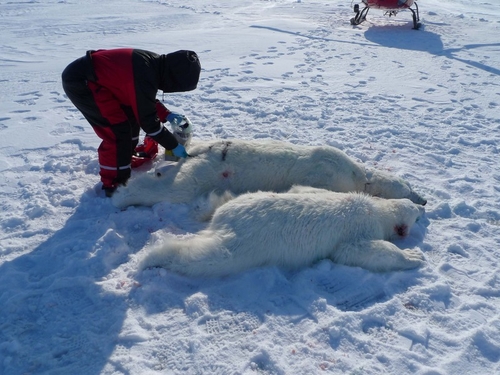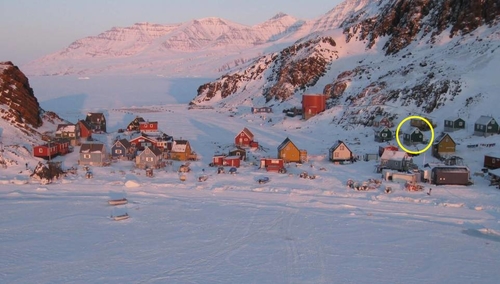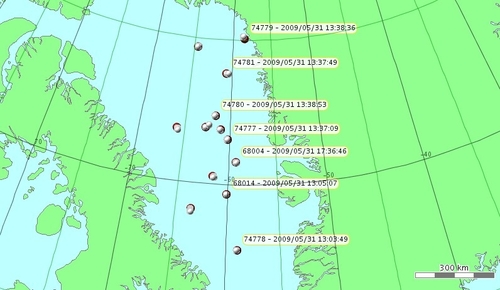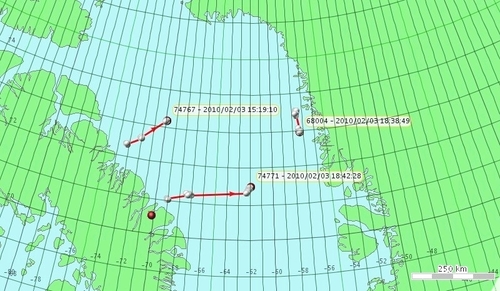Request from GINR: Do not shoot polar bears wearing satellite transmitters Published 23.02.2010

A polar bear wearing a satellite transmitter was shot in Upernavik in February. The polar bear was tagged in 2009 as part of an investigation of the movements of polar bears conducted by the Greenland Institute of Natural Resources (GINR). The investigation was commissioned by the Greenland Bureau of Minerals and Petroleum and costs our society around DKK 200,000 per bear wearing a transmitter. GINR requests that people do not shoot these bears.
Comment by GINR in AG Wednesday 3 March 2010
Polar bear on the move – to Heaven
On Monday 8 February, two brothers hunting a little northwest of Upernavik catch sight of a bear. The polar bear is shot and turns out to be wearing a white collar. This particular bear – number 68004 – is quite well known to GINR. The white collar is a transmitter revealing the movements of the polar bear to scientists via satellites.
Just under a year’s data
On 10 April 2009 a team of biologists and local hunters find fresh bear tracks in the drift ice west of Uummannaq. From a helicopter they catch sight of a grown female with a cub around 2 years old, and a few minutes later both animals lie sedated and sleeping peacefully on an ice floe. A transmitter is placed around the neck of the mother. For just under a year, the scientists were able to track her movements.
Why are the polar bears tagged?
In preparation of coming oil boring activities, a large regional environmental investigation is being conducted in the Qeqertarsuaq/Disko West area. Over 3 years, a number of investigations of marine mammals and birds and the marine benthic environment are being conducted within a total project framework of USD 3.5M. In this connection, the Bureau of Minerals and Petroleum have asked GINR to investigate the movements of polar bears in the area in order to be able to assess how oil boring activities may affect polar bears.
Niaqornat
In April 2009, a team of scientists stayed at GINR’s field laboratory in Niaqornat on the tip of Nuussuaq in the Uummannaq area. When the weather permitted, they flew west across the drift ice to search for polar bears. On some of the trips hunters from Niaqornat accompanied them as guides. When a polar bear was spotted, it was sedated and equipped with a transmitter. Via satellite, the transmitter reveals the movements of the polar bear. The collar transmitters, which are placed on grown females, will work for some years. In addition, small satellite transmitters were placed in the ears of males and young animals. They transmit for only ½ year, however, due to the small size of the batteries.
A year in the life of 68004
In April and May 2009, 68004 and her cub roamed the drift ice west of Qeqertarsuaq and Uummannaq. But global warming has struck in Greenland as well, and, in 2009, the ice in West Greenland was melting rapidly. As the drift ice melted, the two bears moved west towards Canada. The cub probably left its mother at some point on the way – bear cubs generally do so when they are around 2.5 years old. But the transmitter revealed that the mother spent her summer on the shore of Baffin Island, Canada. When the sea ice was re-established in October, she stepped onto it and returned to her old hunting grounds in West Greenland. Polar bears tend to return to places where they have been before, and so did 68004. On 10 December she was less that 100 km from the place where she was tagged. She then wandered back and forth along the edge of the drift ice off the coast until she met her fate in Upernavik.
Hunters must live, too
The hunter is probably happy. He can expect to earn DKK 5,000-10,000 depending on the quality of the skin. However, these years it is becoming more difficult to sell skins. Since 2008 , exporting polar bear products has been totally banned in Greenland. This poses an interesting problem: the hunter secured himself an income by shooting a polar bear, but, at the same time, around DKK 200,000 was invested in each polar bear equipped with a transmitter west of Qeqertarsuaq in 2009, and society could have used more data on the movements of bear 68004. Therefore, GINR requests that people do not shoot these bears.
Facts about the investigation
- The Bureau of Minerals and Petroleum commissioned the investigation of polar bears from GINR. The investigation covers 3 years and costs a good DKK200,000 per polar bear wearing a transmitter.
- In spring 2009, our team of scientists equipped a total of 15 polar bears with transmitters west-northwest of Qeqertarsuaq/Disko. Five transmitters were collar-type and the rest were ear transmitters.
- The reason only grown females are equipped with collar transmitters is that the males’ necks are too wide and conical for the transmitters to stay in place.
Right now, GINR is collaborating with other institutions on analyses of the movements in relation to season, ice cover, etc. to report the polar bears’ preferred areas to the Bureau of Minerals and Petroleum.
- Pinngortitaleriffiks feltstation i Niaqornat Foto: Erik W. Born
- On 8 Februrary 2010, bear no. 68004, who was wearing a transmitter, was killed at Upernavik. Photo: Niels Hansen
- On 31 May 2009, polar bear no. 68004 was on her way to Canada on the edge of the drift ice together with other polar bears wearing transmitters. GINR
- On 3 February bear no. 68004 was close to Upernavik. Two other bears were on their way across the ice from Canada to Greenland, while a fourth bear remained in Canada. GINR





